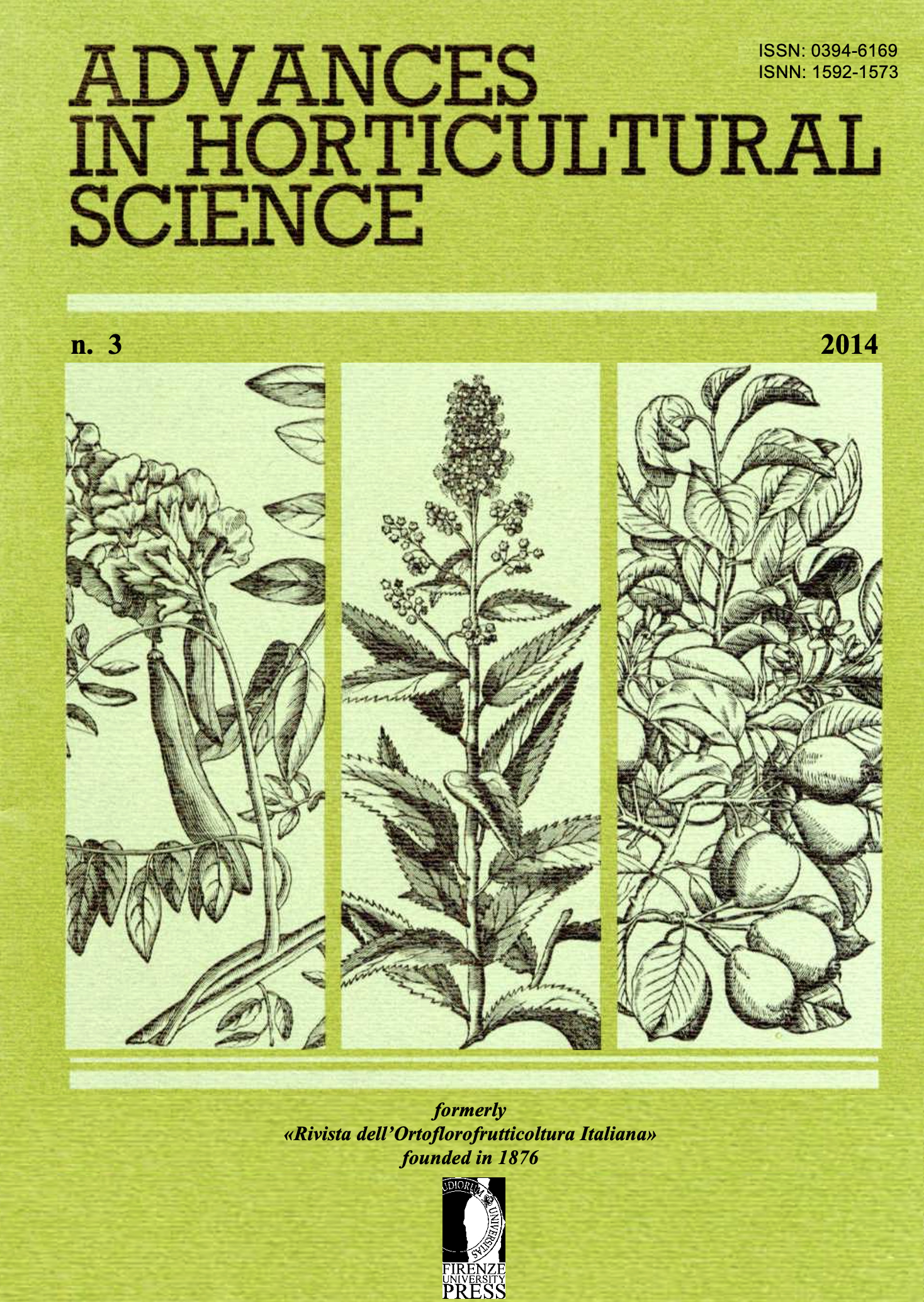Cultural and genetic evaluation of Cochliobolus sativus during successive passages through suscepible barley
Published 2014-06-30
Keywords
- Cochliobolus sativus,
- Hordeum vulgare,
- phenotypes,
- spot blotch
How to Cite
Copyright (c) 2014 M.I.E. Arabi, M. Jawhar

This work is licensed under a Creative Commons Attribution 4.0 International License.
Abstract
The objective of this work was to assess the stability of retrotransposons DNA elements and several key phenotypic traits important for virulence of Cochliobolus sativus after serially transferring through susceptible barley plants. A significant increase in virulence was observed in offspring isolates generated from the aggressive isolate Pt4, in contrast to the lack of significant changes in those obtained from the weakly aggressive isolate Pt1 after seven successive passages. No apparent differences in phenotypes, including mycelial growth, conidiation and conidial germination were observed among isolates from the same parent isolate on artificial medium. Based on retrotransposon microsatellite amplified polymorphism (REMAP), parents and their generations were identical during the serial transfers. Taken together, our results suggest that all singleconidials of the parents and their generations were stable genotypically during seven serial transfers with a change in virulence of the aggressive isolate generations.
References
- ANONYMOUS, 1988 - STAT-ITCF, Programme, MICROSTA, realized by ECOSOFT, 2nd Ver. - Institut Technique des Cereals et des Fourrages, Paris, pp. 55.
- ARABI M.I.E., 2005 - Inheritance of partial resistance to spot blotch in barley. - Plant Breeding, 124: 605-607. DOI: https://doi.org/10.1111/j.1439-0523.2005.01156.x
- ARABI M.I.E., JAWHAR M., 2001 - The response of Cochliobolus sativus to ultraviolet - C - radiation. - Journal of Phytopathology, 149: 521-525. DOI: https://doi.org/10.1046/j.1439-0434.2001.00669.x
- ARABI M.I.E., JAWHAR M., 2003 - Pathotypes of Cochliobolus sativus (spot blotch) on barley in Syria. - Journal of Plant Pathology, 85: 193-196.
- ARABI M.I.E., JAWHAR M., 2007 - Molecular and pathogenic variation identified among isolates of Cochliobolus sativus. - Australasian Plant Pathology, 36: 17-21. DOI: https://doi.org/10.1071/AP06081
- BISWAS M.K., XU Q., DENG X.X., 2010 - Utility of RAPD, ISSR, IRAP and REMAP markers for the genetic analysis of citrus spp. - Science Horticulture, 124: 254-261. DOI: https://doi.org/10.1016/j.scienta.2009.12.013
- BRIGGS S.P., JOHAL G.S., 1994 - Genetics patterns of plant host-parasite interactions. - Trends in Genetics, 10: 12-16. DOI: https://doi.org/10.1016/0168-9525(94)90013-2
- CHADHA S., GOPALAKRISHNA T., 2005 - Retrotransposonmicrosatellite amplified polymorphism (REMAP) markers for genetic diversity assessment of the rice blast pathogen (Magnaporthe grisea). - Genome, 48: 943-945. DOI: https://doi.org/10.1139/g05-045
- FETCH T.C., STEFFENSON B.J., 1999 - Rating scales for assessing infection responses of barley infected with Cochliobolus sativus. - Plant Disease, 83: 231-217. DOI: https://doi.org/10.1094/PDIS.1999.83.3.213
- FLOR H.H., 1956 - The complementary genetic systems in flax and flax rust. - Advances in Genetics, 8: 29-54. DOI: https://doi.org/10.1016/S0065-2660(08)60498-8
- GILCHRIST S., VIVAR F.L.H., GONZALEZ C., VELAQUEZ C., 1995 - Selecting sources of resistance to Cochliobolus sativus under subtropical conditions and preliminary loss. - Rachis, 14: 35-40.
- GONTARIU I., ENEA I.C., 2012 - Studies on the efficiency of some fungicide at two-row spring barley for fighting against spot blotch (Cochliobolus sativus Ito and Kurib) in the North-West Suceava Plateau. - Agriculture Journal, 7: 70-73.
- GOODWIN S.B., SUJKOWSKI L.S., FRY W.E., 1995 - Rapid evolution of pathogenicity within clonal lineages of the potato late blight disease fungus. - Phytopathology, 85: 669-676. DOI: https://doi.org/10.1094/Phyto-85-669
- JIMÉNEZ-GASCO M.M., MILGROOM M.G., JIMÉNEZ-DIAZ R.M., 2004 - Stepwise evolution of races in Fusarium oxysporum f. sp. ciceris inferred from fingerprinting with repetitive DNA sequences. - Phytopathology, 94: 228-235. DOI: https://doi.org/10.1094/PHYTO.2004.94.3.228
- KALENDAR R., GROB T., REGINA M., SUONIEM A., SCHULMAN A., 1999 - IRAP and REMAP: two new retrotransposon-based DNA fingerprinting techniques. - Theoretical and Applied Genetics, 98: 704-711. DOI: https://doi.org/10.1007/s001220051124
- KUMAR J., SCHAFER P.R., LANGEN G., BALTRUSCHAT H., STEIN E., NAGARAJAN S., KOGEL H.K., 2002 - Bipolaris sorokiniana, a cereal pathogen of global concern: cytological and molecular approaches towards better control. - Molecular of Plant Pathology, 3: 185-195. DOI: https://doi.org/10.1046/j.1364-3703.2002.00120.x
- LATTERELL F.M., ROSSI A.E., 1986 - Logevity and pathogenic stability of Pyricularia oryzae. - Phytopathology, 76: 231-235. DOI: https://doi.org/10.1094/Phyto-76-231
- LEACH J., FINKELSTEIN D.B., RAMBOSEK J.A., 1986 - Rapid miniprep of DNA from filamentous fungi. - Fungal Genetics Newsletter, 33: 32-33. DOI: https://doi.org/10.4148/1941-4765.1585
- MATHRE D., 1990 - Compendium of barley diseases. - APS Press, St. Paul, MN, USA, 2nd edition, pp. 90.
- OLBE M., SMMARIN M., GUSTAFSSON M., LUNDBORG, T., 1995 - Effect of the fungal pathogen Bipolaris sorokiniana toxin pre-heminthosporol on barley root plasma membrane vesicles. - Plant Pathology, 44: 625-635. DOI: https://doi.org/10.1111/j.1365-3059.1995.tb01686.x
- PARK S.Y., CHI H.M., MILGROOM M.C., KIM H., HAN S., SKANG S., LE Y.H., 2010 - Genetic stability of Magnaporthe oryzae during successive passages through rice plants and on artificial medium. - The Plant Pathology Journal, 26: 313-320. DOI: https://doi.org/10.5423/PPJ.2010.26.4.313
- POUDYAL S.D., DUVEILLER E., SHARMA R.C., 2005 - Effects of seed treatment and foliar fungicides on Helminthosporium leaf blight and performance of wheat in warmer growing conditions. - Journal of Phytopathology, 153: 401-408. DOI: https://doi.org/10.1111/j.1439-0434.2005.00992.x
- STEFFENSON B.J., HAYES P.M., KLEINHOFS A., 1996 - Genetics of seeding and adult plant resistance to net blotch (Pyrenophora teres f. teres) and spot blotch (Cochliobolus sativus) in barley. - Theoretical of Applied Genetics, 92: 552-558. DOI: https://doi.org/10.1007/BF00224557
- ZADOKS J.C., CHANG T.T., KONZAK C.F., 1974 - A decimal code for the growth stages of cereals. - Weed Research, 14: 415-421. DOI: https://doi.org/10.1111/j.1365-3180.1974.tb01084.x
- ZHOU H., STEFFENSON B., 2013 - Genome-wide association mapping reveals genetic architecture of durable spot blotch resistance in US barley breeding germplasm. - Molecular Breeding, 32: 139-154. DOI: https://doi.org/10.1007/s11032-013-9858-4





